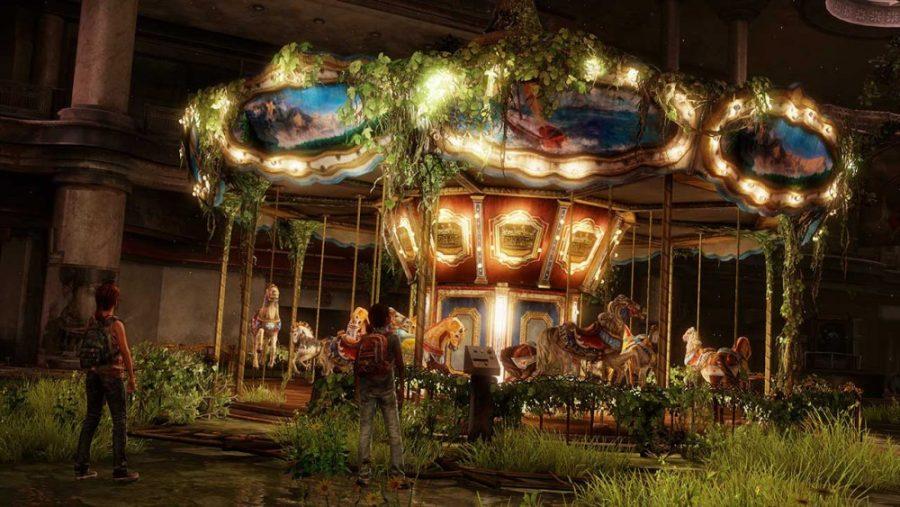When fans like myself found out a few weeks ago that downloadable content for our favorite post-apocalyptic game was coming out on Valentine’s Day, dinner reservations were canceled and money that would have been spent on generic chocolate and flowers was saved for this title. But $15 is a more-than-suitable price for additional content for the game “The Last of Us.”
Naughty Dog’s award-winning title is the pinnacle of video game storytelling. Because of this, writing an in-depth review of the game’s first narrative DLC release, “Left Behind,” presents more spoiler opportunities than talking about “Breaking Bad” in a room full of people still concerned about Krazy 8.
Anything Naughty Dog puts out is worth playing, so I’ll try my best to keep spoilers to a minimum.
This Santa Monica-based developer has created a world so dark and desolate, yet so vivid and expansive, that making the decision to jump in has never been easier, and here’s why:
*
The story*
“Left Behind” helps fill in a notable gap of time that occurs well into “The Last of Us.” Without giving anything away, this gap presents itself shortly before players get to go deer hunting with Ellie.
However, this isn’t the only backstory provided by “Left Behind.” Ellie’s relationship with her best friend, Riley, and her life before Joel are explored as well, adding remarkable depth to Ellie’s character — not that she needed it to begin with.
But I’m not complaining.
The damn-near serene events of Ellie’s life before “The Last of Us” unfold remarkably smoothly alongside the action-packed onslaught of her later struggle. The balance between easy-going narrative and tense action in “Left Behind” is quite something.
Normally when a story is so definitively split like this, I find myself always waiting for a certain part to occur and simply trudging through the side stories. However, “Left Behind” is presented so well that I found myself eager to go further in both the non-combat prologue and the forsaken future.
The gameplay
“The Last of Us” didn’t take home multiple awards because of its narrative alone — the gameplay was top-notch as well. This gameplay remains strong in “Left Behind,” but through the eyes of Ellie, who is a notably different kind of fighter than Joel. As an experienced combatant, it isn’t impossible for Joel to power through a room full of infected on his own with nothing but a hunk of plywood and a handgun.
Ellie, on the other hand, is no tank. Her fighting style is much more elusive and non-aggressive. She has a switchblade, which is useful for quick stealth kills, but when going head-to-head with any foe, Ellie’s a goner. The smart way to fight in “Left Behind” is to be stealthy and deceptive and provide plenty of distractions for the enemy.
Pitting unsuspecting enemies against clickers with a well-placed throw of a bottle and watching them take each other out from behind cover is as satisfying as it sounds. But not every bit of gameplay requires strategic bottle chucking. Much of “Left Behind” is spent aimlessly wandering an abandoned Massachusetts mall in search of nothing more than friendship. If this sounds at all boring, I assure you it isn’t — Ellie’s time spent with Riley is actually more captivating than her time spent fighting.
The little things
Naughty Dog has been great with specifics since “Crash Bandicoot,” and “Left Behind” is no exception. The detail presented within the world of “The Last of Us” is awe-inspiring, to say the least. Not only does each setting look stunning and feel natural, the materials provided are uniquely fascinating.
Scraps of journals from the members of a wrecked military helicopter have little to do with “Left Behind’s” narrative, yet their inclusion in the DLC was instrumental in creating the effect the game had on me as a player.
I can say the same for the random conversations held between Ellie and Riley. The sheer number of times I caught myself with a dumb smile on my face while exploring the world of “Left Behind” is a testament both to the writers at Naughty Dog and to the voice actors behind Ellie and Riley.
Normally, Facebook connectivity in a game like “The Last of Us” would feel obtrusive and senseless, but Naughty Dog got it right. “Left Behind” includes an optional gameplay segment having to do with the social media icon that is executed so tactfully I’m still reeling from its inclusion in the game — as are my Facebook friends.
In short, “Left Behind” blew me away and presented a narrative gaming experience second only to its parent game. Naughty Dog is the Christopher Nolan of the gaming industry, and that’s a title it’s going to hold.









